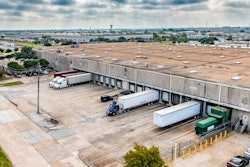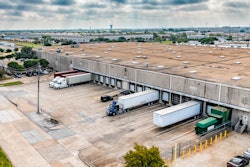
Stability is in store for the rest of this year and 2025, the analysts at FTR Transportation Intelligence said in a Thursday webinar.
That’s good news for the trucking sector, even though interest rates will remain elevated when compared to recent years.
The big picture
Avery Vise, vice president of trucking for FTR, called the next year or so “a sort of balancing out” in macro conditions after the volatility in the market caused by the COVID-19 pandemic.
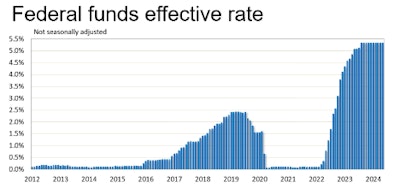
Vise says real gross domestic product will see just over 1% growth through 2024, inching up to the 2% range for 2025. The goods transport sector is similar, he says, and inflation is moderating, as far as goods go. Services are a different picture.
“We are seeing a different experience whether we’re looking at inflation in goods or inflation in services,” Vise says, adding inflation in goods is basically over while inflation in services isn’t moderating and may even be growing.
[RELATED: Mr. Powell has three problems]
“It is reassuring we’ve kind of settled, but it is notable we appear to be settling at a stage considerably higher than we consider to be normal or comfortable,” Vise says, noting the Federal Reserve, who kept interest rates steady this week, would also like to see inflation indices come down.
“They did signal they are planning at least one rate cut this year,” Vise says, but much depends on inflation’s continued cooling.
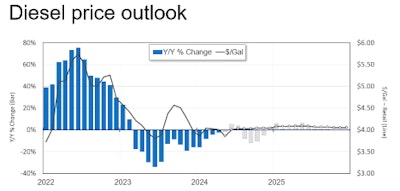
Industry and energy
Industrial production also appears headed toward a slow-and-steady period of growth, says Joseph Towers, FTR’s senior analyst for rail.
“It’s going to be positive,” he says, “but it’s going to be slow.”
FTR’s forecasts show about 1% growth per year, Towers says, with year-over-year declines in industrial production in mining and manufacturing and a slight increase in utilities so far in 2024.
“It’s really been oil and gas driving most of the increases in industrial production, and everything else has been really flat,” Towers says. But this year, oil and gas is slowing down. Oil production grew 8.5% in 2022-2023, and for 2024, FTR is predicting 2.4% growth.
[RELATED: Softening Class 8 market weakened truck sales in Q1]
What that means for diesel prices is — barring any global political crisis — more stability, with prices hovering around $4 per gallon.
Manufacturing will continue its contraction in the near term, Towers says, with a gradual turn into positive territory.
“It’s going to be a very moderate rate,” he says. “It’s not going to be a robust recovery.”
Labor markets
Payroll job growth remains solid, but Vise points out the job market is more complicated than meets the eye.
The Bureau of Labor Statistics tracks two kinds of employment, household and establishment. Household employment tracks jobs held as part of gig work or by independent contractors, while establishment jobs are regular, payroll jobs.
[RELATED: FTC banning non-competes; DOL to update overtime rules]
“In broad terms, employment is reflected in both establishments and households as recovered,” Vise says, with household being slightly weaker than establishment.
Vise says there are no answers for the weakness. The more persuasive of the theories is that people are shifting from gig work and other types of employment not captured by the establishment survey into payroll jobs that are captured.
“We definitely saw this phenomenon a couple of years ago as a lot of one-truck operations were giving up their authority and taking payroll driver jobs,” Vise says. “This will probably all work itself out over a period of months.
Vise predicted labor markets will remain tight for the foreseeable future, as Baby Boomers continue to retire while the labor pool is limited by immigration regulations and a smaller population of available employees.
“As we look ahead, it’s kind of hard to see substantial improvement in the supply of labor,” Vise says, pointing out a recent unemployment figure of 4% was an increase to a four-year high, but still below 2015-2019 levels.
“It’s kind of hard to see it getting too out of hand,” he says.
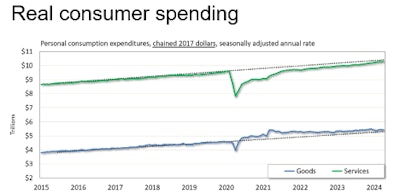
Consumer outlook
Consumer spending, a driver of freight rates, is also normalizing and providing stability in the marketplace. Construction has been more volatile, Vise says.
[RELATED: Freight market unlikely to change fast enough to boost 2024 truck sales]
Services spending is running slightly below the trend line and goods slightly above, Vise says, with some softening in the biggest two categories of durable and non-durable goods.
Household debt payments remain in a comfortable range, but delinquencies are ticking up, raising some eyebrows among market analysts. Vise points out rates are still in a much better position than before the Great Recession in 2008.
What’s more alarming, he says, is the falling personal savings rate. For years before the pandemic, the personal savings rate was around 6%, but it has fallen since the beginning of 2022. Pandemic-era savings, fueled by federal stimulus dollars, is largely depleted, but consumers still have more cash on hand than they would’ve had without COVID-19.
“We’re clearly getting back to a more normal situation, but it’s not clear we’ve completely exhausted the extraordinary government assistance we had,” Vise says.
Carrier numbers have softened recently, but are stabilizing as well, along with spot rates.
“We have knocked out the weakest players,” Vise says, with larger carriers having to adjust their payrolls as the smaller carriers left in the market are in better shape and holding on to their workforce. “Stability is important because you can plan your costs better, and we have been in a very stable spot rate environment.”
